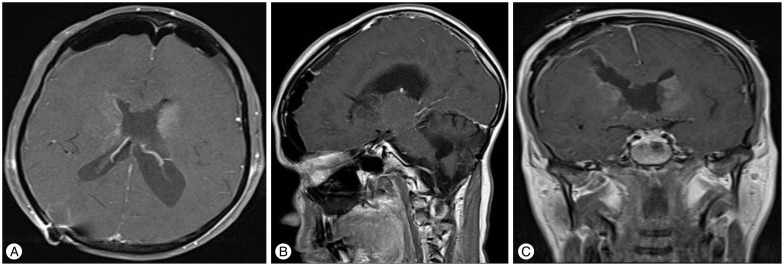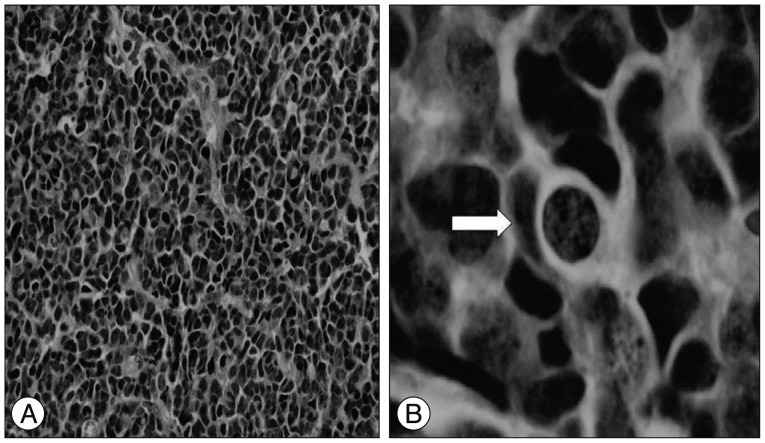Abstract
Medulloblastoma is a common pediatric tumor typically diagnosed before the age of fifteen. Initial therapy includes surgical resection and radiation of the entire neuro-axis. Recurrence is common and typically occurs within 2 years of initial diagnosis. Those fitting Collin's Law is considered tumor-free. We report a case of single supratentorial recurrence 13 years after initial diagnosis. Here we present a 22 year old male presenting 13 years after initial diagnosis with isolated septum pellucidum recurrence. He underwent complete resection of the tumor. Medulloblastoma is a common in the pediatric population. Late recurrence to the ventricular system is uncommon. Long term follow-up is recommended in these patients.
Medulloblastoma (MB) is the most common malignant tumor in children, accounting for 15 to 25% of all childhood brain tumors192021). Occurrence in the adult population is also well documented, but only accounts for 1% of adult tumors11). Treatment includes surgical resection followed by radiotherapy of the entire neuro-axis and chemotherapy451923).
Recurrence of this tumor is well recognized and may require salvage therapy. Time to recurrence typically occurs within two years of initial diagnosis in the pediatric population. Tumors that follow Collin's Law (tumor free period of 9 months plus the age at diagnosis) are considered to be cured11920). However, late recurrence of MB has been documented in the pediatric population23121323).
A 22-year-old male with a history of a medulloblastoma at 9 years of age, removed surgically and treated with adjuvant craniospinal irradiation and chemotherapy presented with 2.5 weeks of progressive gait ataxia and headache.
Patient was alert and oriented. The right pupil was sluggish. The left pupil was reactive and the left eye deviated uncontrollably on exam. The left upper extremity had 4/5 strength. CT scan showed an anterior septum pellucidum mass at the foramen of Monro with secondary obstructive hydrocephalus (Fig. 1).
Medulloblastoma, a malignant tumor typically arising from the cerebellar vermis in young children and lobes in older children, represents 4–8% of all intracranial tumors, and is the most common malignant central nervous system tumor of childhood192021), with approximately 80% occurring in patients under 15 years of age21). It accounts for 15–25% of all childhood brain tumors in comparison with only 1% of adult intracranial neoplasms, with a slight male predominance in both groups1920212324).
Presenting features of medulloblastoma are generally related to hydrocephalus (found radiographically in 97% of patients) and cerebellar dysfunction which include : headache, nausea/vomiting, truncal ataxia, and unsteady gait23). Approximately 83% are found in the midline in children, while 49% of adult tumors are lateral21).
Differences in childhood and adult tumors can also be observed in terms of histologic variant. Classical histologic presentation of medulloblastoma includes densely-packed primitive cells with hyperchromatic nuclei, scant cytoplasm, and nuclear molding120). This classical tumor histology is more common in children821). Homer-Wright rosettes may be seen10). Adults are more likely to have laterally-located tumors, which more often desmoplastic51021). Both tumor types include markers of neuronal lineage, such as class III beta tubulin and MAP-2 neurofilaments, whereas more adult tumors will express GFAP1020). The anaplastic/ large cell variant is more frequently seen in older children and adults.
MB tends to seed the cerebrospinal fluid resulting in extensive leptomeningeal involvement, and treatment therefore requires surgical resection followed by neuro-axis radiotherapy and chemotherapy7171923). Recurrence in the pediatric population differs from that seen in adults. Age at diagnosis has been shown to be a significant predictor of time until relapse24). The majorities of pediatric recurrences are within two years of initial diagnosis, and are in the posterior fossa192024). Those with tumor-free period equal to the age at diagnosis plus nine months may be considered cured (Collin's Law)14181920). While a good predictor of many childhood tumors, there are known exceptions to Collins law for MB1269131822). However, a recent review of 125 patients by Massimino et al.1415), gender, age at diagnosis, metastases, and therapeutic protocol were shown to have no prognostic impact.
In the event of recurrence, relapse at a single site and further out from initial time of diagnosis is considered a more favorable prognostic indicator15). Recurrences are most common in the posterior fossa, followed by spinal, supratentorial and boney metastases23). Supratentorial dissemination is often found in the subfrontal area and may be due to overly generous radiation protection of the orbital roof to prevent irradiation of the cribiform plate, allowing for a nidus of recurrence16). Late recurrence of MB in the supratentorial ventricular compartment is uncommon. We present a case of late recurrent MB 13 years after initial diagnosis, again validating the need for long term follow-up in the pediatric population following diagnosis of MB.
Recurrence of MB is common and often occurs in the posterior fossa. Supratentorial dissemination of MB is more common in the subfrontal region. Supratentorial recurrence of MB not following Collin's Law is extremely uncommon, especially within the supratentorial ventricular system. We present a case of a 22 years old male who presented 13 years following his initial diagnosis of MB with symptoms of obstructive hydrocephalus from a septum pellucidum recurrence. Continued close follow-up is need in pediatric patients after resection and radiation for MB given their unexpected recurrence pattern.
References
1. Allan R, Gill A, Spittaler P. Recurrent medulloblastoma--violation of Collin's law by 14 years. J Clin Neurosci. 2004; 11:756–757. PMID: 15337141.
2. Amagasaki K, Yamazaki H, Koizumi H, Hashizume K, Sasaguchi N. Recurrence of medulloblastoma 19 years after the initial diagnosis. Childs Nerv Syst. 1999; 15:482–485. PMID: 10502011.

3. Belza MG, Donaldson SS, Steinberg GK, Cox RS, Cogen PH. Medulloblastoma : freedom from relapse longer than 8 years--a therapeutic cure? J Neurosurg. 1991; 75:575–582. PMID: 1885975.

4. Brown WD, Tavaré CJ, Sobel EL, Gilles FH. Medulloblastoma and Collins' law : a critical review of the concept of a period of risk for tumor recurrence and patient survival. Neurosurgery. 1995; 36:691–697. PMID: 7596498.
5. Buglione M, Triggiani L, Grisanti S, Liserre R, Buttolo L, Gipponi S, et al. Retreatment of recurrent adult medulloblastoma with radiotherapy : a case report and review of the literature. J Med Case Rep. 2013; 7:64. PMID: 23497715.
6. Cieślak E, Kepka L, Fijuth J, Marchel A, Kroh H. Very late relapse of medulloblastoma. Folia Neuropathol. 2004; 42:49–53. PMID: 15119746.
7. David KM, Casey AT, Hayward RD, Harkness WF, Phipps K, Wade AM. Medulloblastoma : is the 5-year survival rate improving? A review of 80 cases from a single institution. J Neurosurg. 1997; 86:13–21. PMID: 8988076.
8. Ferrante L, Mastronardi L, Celli P, Acqui M, Cervoni L, Fortuna A. Medulloblastoma in adulthood. J Neurosurg Sci. 1991; 35:23–30. PMID: 1890457.
9. Friedberg MH, David O, Adelman LS, Heilman CB. Recurrence of medulloblastoma : violation of Collins' law after two decades. Surg Neurol. 1997; 47:571–574. PMID: 9167782.

10. Giordana MT, Cavalla P, Dutto A, Borsotti L, Chiò A, Schiffer D. Is medulloblastoma the same tumor in children and adults? J Neurooncol. 1997; 35:169–176. PMID: 9266455.
11. Giordana MT, Schiffer P, Lanotte M, Girardi P, Chio A. Epidemiology of adult medulloblastoma. Int J Cancer. 1999; 80:689–692. PMID: 10048968.

12. Hardy DG, Hope-Stone HF, McKenzie CG, Scholtz CL. Recurrence of medulloblastoma after homogeneous field radiotherapy. Report of three cases. J Neurosurg. 1978; 49:434–440. PMID: 682006.
13. King GA, Sagerman RH. Late recurrence in medulloblastoma. Am J Roentgenol Radium Ther Nucl Med. 1975; 123:7–12.

14. Massimino M, Antonelli M, Gandola L, Miceli R, Pollo B, Biassoni V, et al. Histological variants of medulloblastoma are the most powerful clinical prognostic indicators. Pediatr Blood Cancer. 2013; 60:210–216. PMID: 22693015.

15. Massimino M, Casanova M, Polastri D, Biassoni V, Modena P, Pecori E, et al. Relapse in medulloblastoma : what can be done after abandoning high-dose chemotherapy? A mono-institutional experience. Childs Nerv Syst. 2013; [Epub ahead of print].
16. Miralbell R, Bleher A, Huguenin P, Ries G, Kann R, Mirimanoff RO, et al. Pediatric medulloblastoma : radiation treatment technique and patterns of failure. Int J Radiat Oncol Biol Phys. 1997; 37:523–529. PMID: 9112448.

17. Nigri F, Telles C, Acioly MA. Late obstruction of an endoscopic third ventriculostomy stoma by metastatic seeding of a recurrent medulloblastoma. J Neurosurg Pediatr. 2010; 5:641–644. PMID: 20515341.

18. Nishio S, Morioka T, Takeshita I, Fukui M. Medulloblastoma : survival and late recurrence after the Collins' risk period. Neurosurg Rev. 1997; 20:245–249. PMID: 9457719.

19. Roka YB, Bista P, Sharma GR, Adhikari D, Kumar P. Frontal recurrence of medulloblastoma five years after excision and craniospinal irradiation. Indian J Pathol Microbiol. 2009; 52:383–385. PMID: 19679968.

20. Sanders MA, Vitaz T, Rosenblum M, Plaga AR, Parker JC Jr, Parker JR. 46-year-old man with a spinal cord mass. Brain Pathol. 2011; 21:109–112. PMID: 21129065.

21. Sarkar C, Pramanik P, Karak AK, Mukhopadhyay P, Sharma MC, Singh VP, et al. Are childhood and adult medulloblastomas different? A comparative study of clinicopathological features, proliferation index and apoptotic index. J Neurooncol. 2002; 59:49–61. PMID: 12222838.
22. Stevens B, Razzaqi F, Yu L, Craver R. Late recurrence of medulloblastoma. J La State Med Soc. 2008; 160:138–141. PMID: 18655650.
23. Sun LM, Yeh SA, Wang CJ, Huang EY, Chen HC, Hsu HC, et al. Postoperative radiation therapy for medulloblastoma--high recurrence rate in the subfrontal region. J Neurooncol. 2002; 58:77–85. PMID: 12160144.
24. Tabori U, Sung L, Hukin J, Laperriere N, Crooks B, Carret AS, et al. Distinctive clinical course and pattern of relapse in adolescents with medulloblastoma. Int J Radiat Oncol Biol Phys. 2006; 64:402–407. PMID: 16198067.

Fig. 1
CT brain without contrast (B) showing a septal lesion causing obstruction of the foramen Monro resulting in obstructive hydrocephalus. (A) MRI of the brain without contrast on 7/14/2009 last scan prior to recent presentation.

Fig. 2
MRI with contrast axial (A), sagittal (B), and coronal (C) showing a homogenously enhancing septal mass obstructing the foramen Monro.





 PDF
PDF ePub
ePub Citation
Citation Print
Print




 XML Download
XML Download